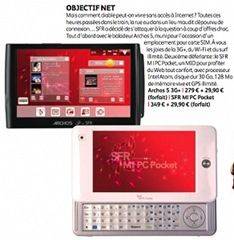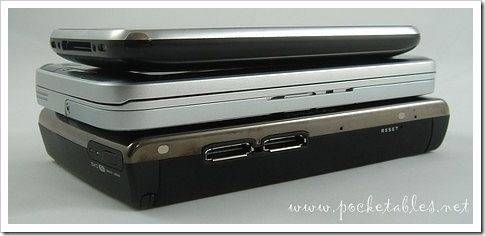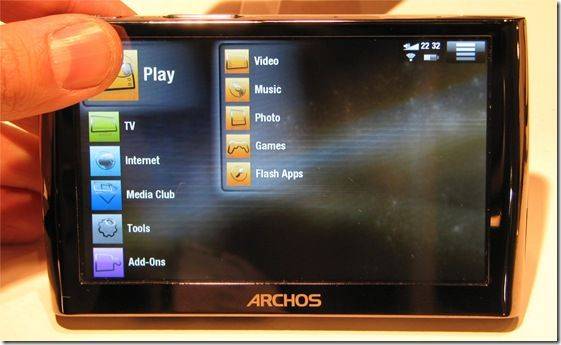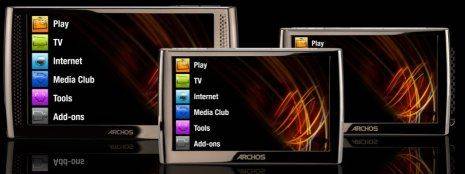
Posted on 09 February 2009
This could be a great move for Andriod, TI and Archos as thay are getting together to build what could be a very interesting MID. A true crossover smartphone/web/PMP device. It will combine the Archos’ PMP charachteristics, its powerful OMAP 3 platform, the Android OS and the following features.
- PC-like Internet experience enhanced by a high-resolution 5″ screen and full-width page viewing
- Adobe Flash(TM) and Flash Video(TM) support, full screen
- Access whenever and wherever to TV, movies, photos, music and games
- Uncompromised TV recording and High Definition (HD) playback, all formats
- Hundreds of hours of video storage, up to 500 GB
- Innovative design: compact 10-mm ultra-thin tablet
- Long battery life, 7 hours’ video playback
- 3.5G 7.2 Mb/s HSUPA
- Laptop-like performance from the first implementation of OMAP3440 processor based on the ARM® Cortex(TM) superscalar microprocessor and DSP
With a 10mm depth, we can probably count out any possibility of a keyboard which could be a huge shame as the platform is powerfull enough to drive some nice, rich web apps.
I wonder if they would combine the docking station and some hdmi action to make it desktop–friendly. How about a netbook shaped dock too?
Expect to hear more about this at the Mobile World Congress which kicks off this week.
jkOnTheRun » Blog Archive ARCHOS Adds Android Telephony to Mobile Internet Device «.

Posted on 24 October 2008
 Jenn (Pocketables) picked up the latest information on the Archos 5G and Mi PC from a few sites yesterday and it seems that Stuff magazine got some deets wrong. Pff! You can never trust these professional publications ;-)
Jenn (Pocketables) picked up the latest information on the Archos 5G and Mi PC from a few sites yesterday and it seems that Stuff magazine got some deets wrong. Pff! You can never trust these professional publications ;-)
The Archos 5G is 249 Euros with a 19 Euro/month. 500MB data limit then throttled. Unsibsidised it will be 449 Euros, exactly where I would expect it to be. The Mi PC (based on the Compal MID that you see in the Aigo and Gigabyte models) will also 249 euros on a 19/month contract but it seems that you have to use a mail-in rebate for that. The unsubsisided price is unknown.
There were also a couple of errors in the specifications that I’ve updated in the Mi PC product page. We’ll get the 5G in the DB ASAP.

Posted on 22 October 2008
 I heard late-yesterday from Intel that the Compal MID was coming to France and was just waiting for confirmation to post the news but I need wait no longer as Stuff Magazine have done it for me. Pocketables have just picked up the story and it makes interesting reading for all of us that are frustrated at the progress in the MID department.
I heard late-yesterday from Intel that the Compal MID was coming to France and was just waiting for confirmation to post the news but I need wait no longer as Stuff Magazine have done it for me. Pocketables have just picked up the story and it makes interesting reading for all of us that are frustrated at the progress in the MID department.
We knew that SFR would carry the Archos 5G and my guess at the unsubsidised cost was between 400 and 500 Euro. It turns out that SFR will sell the 5G for about 280 Euros plus 30 Euros per month. That’s slightly more than I expected for a subsidised version but in the right ball-park.
As for the MID (made by Compal – its the same as the Aigo and Gigabyte MIDs under the hood) it looks like it will be branded as the ‘Mi PC Pocket’ [reach!] and will be slightly more expensive at 349 Euro plus 30 Euro per month. As far as I know, SFR will have to abide by local law and sell these devices unsubsidised and unlocked so expect 100-200 Euro on top of these costs if you want an outright purchase. Hopefully, the UI will be language-switchable.
Notice the offset keyboard on the Mi PC. It’s offset to provide what looks like a simple 4-way circular rocker and select button. Also note that it’s got a 30GB hard drive.
Apparently there’s a press event by SFR later this week tomorrow where the two devices will be formally announced.
Details (based on what we know) now in the database.
Original: jbmm.fr

Posted on 13 October 2008
‘Faster over fuller’ is the expression Jenn uses to describe how consumers want their browsing experience and I tend to agree. Personally I want Firefox 3+add-ons for my browser as it’s long my most important piece of software but I’m not most consumers. A consumer MID doesn’t need to be 100% FIE for most people but it does need to be close.

The browser on the Archos 5 is, relative to existing consumer and smartphone-based browsers, a big step forward in the eyes of most people that have tested it so it’s nice to confirm it with some stats. Jenn has lined-up the Archos 5, the iPhone 3G and the Nokia N810 in a browser speed test and overall, you’re seeing page load times 1.5 times faster than an iPhone 3G and about 1.8 times faster than a Nokia N810. But is it fast enough? MIDs and low-end UMPCs are likely to beat these times and return more accurate results but does the difference really matter?
What we’re seeing here is proof of, not just a fast new Archos device, but how the ARM Cortex core could improve the Internet experience. In this case, the ARM core is sitting on the Ti OMAP platform but Ti aren’t the only people using it. Intel really do need to watch their backs in this territory now because they’re not fighting against relatively small companies like AMD and VIA here, they’re fighting against the huge ARM ecosystem and they certainly know a thing or two about mobile hardware and software.
Read about the 3-way test at Pocketables.

Posted on 27 September 2008
I don’t usually spend Saturday morning reading investor presentations and I can’t even remember how I got here but it’s interesting to look at the 22 April 2008 investor presentation from Archos. The personal media player company sees a migration to MIDs happening in the next 2 years. They also say that there is only one Internet, it needs a minimum 5″, 800×480 screen, that the MID market will 70M units in size by 2010. They also highlight to trends. 1) 3G is all-over in Western Europe and 2) Ultra Low Power X86 processors are becoming reality and that mobile devices will run standard PC applications in 2009.
There are no presentation notes or audio accompanying the slides here so I’m having trouble putting that last statement into context. Did Archos imply that they will have to follow the ‘reality’ and run standard PC applications? I.e. Go X86? Or did Chief executive Henri Crohas talk about the Archos’ competitive advantage in this X86-based market when he showed that slide? The Archos 5 has just been released and its based on a ARM/Ti platform but this product is probably a result of 18 months dev work. The low power X86 platforms didn’t exist then. They do now though so if Archos believe that the PMP market is evolving to a point where the Internet aspect is more important, would they switch CPU architectures?





Images taken from Archos Investor Presentation. 22 April 2008.(PDF).
I do believe that the X86-based platform has more potential both from the software dev and technology aspects and I’ve made predictions that Archos could move to X86 in the past but there are some changes happening in the market and unpredictable forces out there. An expensive decision like this needs to be low-risk to keep investors happy so I don’t believe that they’ve already made their decision.
Ti are putting a lot of effort into promoting their OMap platform, Nokia are looking to continue with ARM/Linux and there are others important players to consider too. Qualcomm, Apple, Nvidia all have products that could affect the market. On the other hand, Archos have just released a new product and have time before they need to make a decision on a new platform for their next product.
It would be in interesting market indicator if Archos switched to X86 but I guess we’ll have to wait a while before we find out.

Posted on 16 September 2008
When I wrote about Opera 9.5 Mobile a short while back I highlighted how it was a great browser with no hardware to run it on. What I said was that the processing power and screen size wasn’t enough for the software. The user interface was good but in order for it to be taken seriously as a crossover mobile/desktop, entertainment/productivity browser, it needed better hardware so when we heard about the new Archos devices recently and their Cortex ARM general purpose processors we knew there was a chance for some serious challenges to the Intel-based MIDs. The Archos devices have a rich, enjoyable touch user interfaces, very good video performance (see video below) and a suite of content and application accessory offerings that can be bolted on to improve the package further. Add the possibility of getting a 3G-enabled version and you got the makings of what could be one of the best MIDs yet. [More after the pic…]

Read the full story

Posted on 22 August 2008
So yet another name… This time with the wonderful acronym IMT. Anyways, these new Archos devices are running on ARM Cortex CPUs, come with 5 or 7 inch screens, WiFi, and hard drives ranging from 30 to 320 gigabytes. These will also be running Opera with Flash 9 support and have lots of codec support. Most interesting is the 5g model which will include HSDPA. If you are looking for a media player with internet support, this is probably your best choice. Be on the look out for more information.
Via Pocketables.

Posted on 26 April 2008
Archos are moving, very quickly this week it seems, to combine the three major, non-smartphone, consumer mobile activities onto a single device. Thats the high-end PMP function (that requires a 4-6″ screen size,) the mobile Internet (that requires a 4-6″ screen size) and Navigation (that requires a 4-6″ screen size.)

Now i’m not saying that you can’t do those functions on a smaller, or even bigger, device but these are the three areas I see that are absolutely ripe for dropping into a hand-held device where the quality of presentation and capability could be far greater than a smartphone could provide. It’s MID territory…
Read the full story























